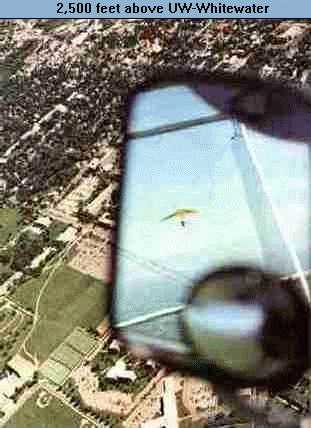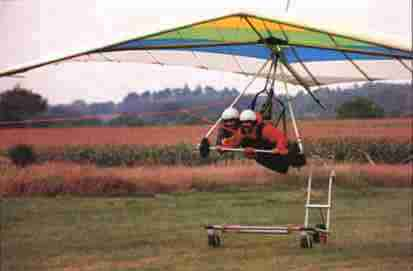

High Tech Hanggliding on a Leash
Article by Brad Kushner, Raven Sky Sports, Whitewater, Wisconsin
A foot-launch free flyer is as free as a bird from the moment he clears launch. That's why most of us pursue hanggliding - the swooping, the soaring, the controlled carving of turns through unseen powder-snow air molecules that give us the same giddy euphoria as our childhood dreams of flight did.
Aerotowing, on the other hand, starts out a lot more like taking a dog for a walk on a leash - wandering in different directions, the master and obedient pooch who learns, sooner or later, that to "heel" or "follow" is in Rover's best interest after all. But, that leash thing! It's definitely something that takes getting used to. Fortunately, it's well worth it. The leash is a small price to pay for a trip to the park, especially since we know we can slip off the leash once we get there.
Aerotowing has opened up new hanggliding opportunities that never existed before, in parts of the country and in weather conditions that are now much more rewarding to sport fliers than they ever were. Experienced hangglider pilots get familiar with aerotowing after brief training and earn an "AT" special skill sign off on their rating cards. Many get spoiled by the convenience of the launch and landing zones being one and the same.
Most hangglider pilots view aerotowing as just an alternative way to get "up there" and, once up, use the same strategies they have always used for soaring in available lifting air. Thermalling and ridge soaring are easily accomplished if the tow aloft brings the pilot to a thermal source or a soarable ridge. Aerotowing has an advantage over automotive towing in that the hangglider can be taken to expected sources of lift that are away from the launch area or runway. Part of the fun of aerotowing is planning the tow portion of the flight: going upwind or across the wind to known thermal sources and staying on tow until a thermal is encountered. Releasing in a thermal is a wonderful feeling!
Novice pilots who are learning to aerotow benefit greatly from tandem instruction. During a lesson plan of three to five hours of dual airtime, a newcomer can learn how to be a good Rover on the way up and how to pilot a free-flying hangglider on the way down. During 10 or more half-hour flights with an instructor, the student learns to coordinate with the aerotug through the launch sequence, then follows on course behind the tug through air currents which inevitably have their ups and downs. The student learns quickly about proper control input and corrections in both speed and direction while on tow. After the tow up and release, typical lesson plans include coordinated turns, stalls and recovery, and landing approaches, all of which are just like any other free-flight hanggliding curriculum. Usually the landing is at the same spot as the launch, and repeat lessons and flights on the same day are very convenient and productive. First solo flights are usually performed in near calm conditions, with the additional support of the instructor's reassuring voice on a two-way radio.

Usually the tug is the faster of the two, and the hangglider has to speed up a bit to match speed. If he doesn't, he'll likely fly too slowly and loft above the aerotug. A well-coordinate aerotow flight usually involves the hangglider pilot pulling in and diving a bit at various times during the flight in order to keep a horizontal relationship with the tug. The tug pilot adjusts airspeed and altitude too, while watching the rear-view mirror to keep the hangglider on the horizon. If it's done right, the hangglider pilot will see the aerotug right on the horizon in front of him, plus or minus 30 feet of altitude.
The glider pilot also has to keep his glider aligned with the tow. If Rover makes a spontaneous turn right or left, within moments the two aircraft will want to pull apart and break free. That isn't as hazardous as it might sound, but near the ground it can be cause for alarm. A hangglider pilot should have confident control of speed and direction in order to aerotow. Typically, we stay on tow about five minutes to 2,000 to 3,000 feet above the ground. The hang glider pilot then triggers a release and flies free, and the tug brings the rope home.
The launch dolly permits the hangglider pilot to take off from level ground without any running, allowing him to concentrate on flight control while the tug does all the work getting both up to airspeed. During the rolling launch, the glider is cradled and supported both by the basetube and the tail. The pilot is suspended about a foot off the ground, prone in his harness. A signal is given to the tug that the hangglider is ready, and the tug accelerates down the runway. Castering wheels on the dolly allow it to track smoothly in the direction of the tow. The dolly is left on the ground when the hangglider lifts off, and usually rolls only 50 yards or so before takeoff. Since most traditional hangglider launches are accomplished while running upright, the prone launch off of the dolly is noticeably different for an experienced pilot. New pilots training on aerotow will wish to supplement their learning with bunny hill lessons for running takeoffs.
The leash or tow rope used in aerotowing is 200 to 300 feet of brightly colored lightweight rope. Polypropylene is what most aerotowers use. We've found a neat little manual reeler at the hardware shop. It's meant for extension cords and stores our 300 feet just right. We keep two tow ropes available at all times, for those occasions when one is accidentally dropped in a hard to find place like Wisconsin. We also discovered (the hard way) that bright yellow polypro becomes invisible in corn or hay fields, so we found some neon-orange rope and hardly ever lose one anymore. It takes only minutes to unspool a tow rope and attach it to the plane and glider.
The tow rope is symmetrical, that is, it is finished with a metal ring at each end so that there's no front or back. The bridle (or V-line, for its shape in flight) on the Dragonfly tow plane's tail functions exactly like the bridle or V-line on the hangglider pilot's harness front. They both have a release mechanism and a safety weak link, and any way you detach, the result is a trailing orange rope and ring. We plan on keeping the rope attached to the Dragonfly but it doesn't always work out that way. So Rover has to be prepared to be unexpectedly turned loose, maybe even with the leash trailing from his collar. A hangglider pilot can wrap that rope around some anchor down there, with hazardous results. We've lassoed cornstalks and dragged them down the runway with the aerotug. A hangglider probably wouldn't win that tug o' war. One should be prepared to get custody of the rope unexpectedly, and if low, release it before it catches on something. (If high, of course, one should bring it back and drop it whe re it can be found.)
The safety weak link is a very important part of the system. Its purpose is to disconnect the hangglider from the tug at any time the tow forces rise above a certain level. There's one at the hang glider end of the rope, and another slightly stronger one at the other end, on the tug. A pilot experiencing a challenging flight, as a result of inexperience or turbulence, will likely break a weak link before the tow is complete. This "accidental" release often prevents a rough ride from developing into a dangerous one, and the glider returns to the launch area and lands.
Heavyweight pilot trainees are finding that their weight isn't as much of a concern when rolling launches are made off the dolly. Even in no wind, the large pilot can achieve takeoff speed effortlessly, even with a tandem instructor aboard! Students weighing more than 250 pounds have flown tandem on aerotow and gone on to solo flights. Since hanggliders come in many different sizes, small people and large people can use the best available equipment to meet their needs.
 , Florida
, Florida| Return to Hang Gliding Club home page |
|---|